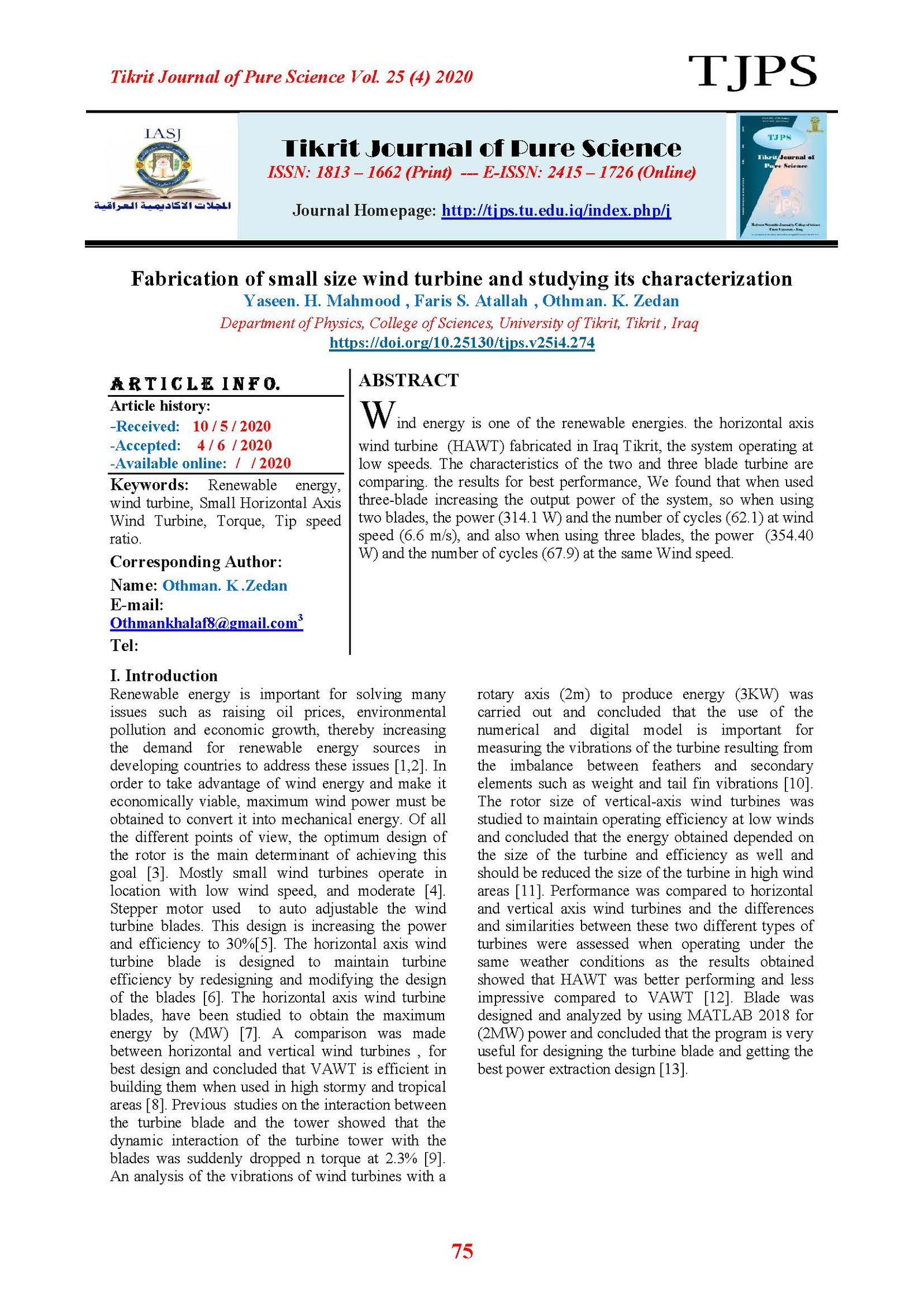Fabrication of small size wind turbine and studying its characterization
Main Article Content
Abstract
Wind energy is one of the renewable energies. the horizontal axis wind turbine (HAWT) fabricated in Iraq Tikrit, the system operating at low speeds. The characteristics of the two and three blade turbine are comparing. the results for best performance, We found that when used three-blade increasing the output power of the system, so when using two blades, the power (314.1 W) and the number of cycles (62.1) at wind speed (6.6 m/s), and also when using three blades, the power (354.40 W) and the number of cycles (67.9) at the same Wind speed.
Article Details

This work is licensed under a Creative Commons Attribution 4.0 International License.
Tikrit Journal of Pure Science is licensed under the Creative Commons Attribution 4.0 International License, which allows users to copy, create extracts, abstracts, and new works from the article, alter and revise the article, and make commercial use of the article (including reuse and/or resale of the article by commercial entities), provided the user gives appropriate credit (with a link to the formal publication through the relevant DOI), provides a link to the license, indicates if changes were made, and the licensor is not represented as endorsing the use made of the work. The authors hold the copyright for their published work on the Tikrit J. Pure Sci. website, while Tikrit J. Pure Sci. is responsible for appreciate citation of their work, which is released under CC-BY-4.0, enabling the unrestricted use, distribution, and reproduction of an article in any medium, provided that the original work is properly cited.
References
[1] Hamdan, A.; Mustapha, F.; Ahmad, K. A. and Rafie, A. M. (2014). A review on the micro energy harvester in Structural Health Monitoring (SHM) of biocomposite material for Vertical Axis Wind Turbine (VAWT) system: A Malaysia perspective. Renewable and Sustainable Energy Reviews, 35, 23-30. [2] Ellabban, O.; Abu-Rub, H. and Blaabjerg, F. (2014). Renewable energy resources: Current status, future prospects and their enabling technology. Renewable and Sustainable Energy Reviews, 39, 748-764. [3] Mandas, N.; Cambuli, F. and Carcangiu, C. E. (2006). Numerical prediction of horizontal axis wind turbine flow. University of Caglairi, EWEC. [4] Ani, S. O., Polinder, H., & Ferreira, J. A. (2012, September). Low cost axial flux PM generator for small wind turbines. In 2012IEEE Energy Conversion Congress and Exposition (ECCE) (pp. 2350-2357). IEEE. [5] Upadhaya, K. G.; Verma, A.; Tripathi, M. M. and Kumar, R. (2014, December). Design of adjustable blade wind turbine for constant generated power. In 2014 6th IEEE Power India International Conference (PIICON) (pp. 1-5). IEEE. [6] Rehman, S.; Alam, M.; Alhems, L. M. and Rafique, M. M. (2018). Horizontal axis wind turbine blade design methodologies for efficiency enhancement—A review. Energies, 11(3), 506. [7] Kohli, N. K. and Ahuja, E. HAWT POWER ENHANCEMENT USING ITS CHARACTERISTICS. [8] Johari, M. K.; Jalil, M. A. A. and Shariff, M. F. M. (2018). Comparison of horizontal axis wind turbine (HAWT) and vertical axis wind turbine (VAWT). International Journal of Engineering and Technology, 7(4.13), 74-80. [9] Shkara, Y.; Cardaun, M.; Schelenz, R. and Jacobs, G. (2019).Aeroelastic response of a multi-megawatt upwind HAWT based on fluid-structure interaction simulation. wind energy science,
https://doi .org/10.5194/wes-2019-29 [10] Castellani, F. et al. (2018). Experimental and numerical vibrational analysis of a horizontal-axis micro-wind turbine. Energies, 11(2), 456. [11] Doerffer, P.; Doerffer, K.; Ochrymiuk, T. and Telega, J. (2019). Variable Size Twin-Rotor Wind Turbine. Energies, 12(13), 2543. [12] Mendoza, V.; Chaudhari, A. and Goude, A. (2019). Performance and wake comparison of horizontal and vertical axis wind turbines under varying surface roughness conditions. Wind Energy, 22(4), 458-472.
[13] Dereje, G. and Yigezu, B. S. (2019). Design and Analysis of 2MW Horizontal Axis Wind Turbine Blade. IJISET - International Journal of Innovative Science, Engineering & Technology, 6(5), 2348 – 7968. [14] Akinpelu, A.; Emetere, M. E. and Akinwumi, S. A. (2019, September). Evaluation Of Wind Energy Potentials In Ota, Ogun State, Nigeria. In IOP Conference Series: Earth and Environmental Science (Vol. 331, No. 1, p. 012024). IOP Publishing. [15] Kishore, R. A. and Priya, S. (2013). Design and experimental verification of a high efficiency small wind energy portable turbine (SWEPT). Journal of wind engineering and industrial aerodynamics, 118, 12-19. [16] Mohammed, A. A.; Ouakad, H. M.; Sahin, A. Z. and Bahaidarah, H. (2019). Vertical axis wind turbine aerodynamics: summary and review of
momentum models. Journal of Energy Resources Technology, 141(5). [17] Mahmood, Y. H. (2019). Fabricated of Vertical Axis wind turbine (VAWT) and study the parameter. Tikrit Journal of Pure Science, 24(7), 99-103. [18] Tan, R. H. and Teow, M. Y. (2016). The Performance Evaluation of Horizontal Axis Wind Turbine Torque and Mechanical Power Generation Affected by the Number of Blade. In MATEC Web of Conferences (Vol. 70, p. 03002). EDP Sciences. [19] Wenehenubun, F.; Saputra, A. and Sutanto, H. (2015). An experimental study on the performance of Savonius wind turbines related with the number of blades. Energy procedia, 68, 297-304. [20] Delafin, PL. (2016). Effect of the number of blades and solidity on the performance of a vertical axis wind turbine. Journal of Physics: Conference Series 753 (2016) 022033. [21] El-Ghazali, A. (2016). The influence of turbine geometry on the performance of c-section vertical axis wind turbine (Doctoral dissertation, Master’s thesis, Near East University).
